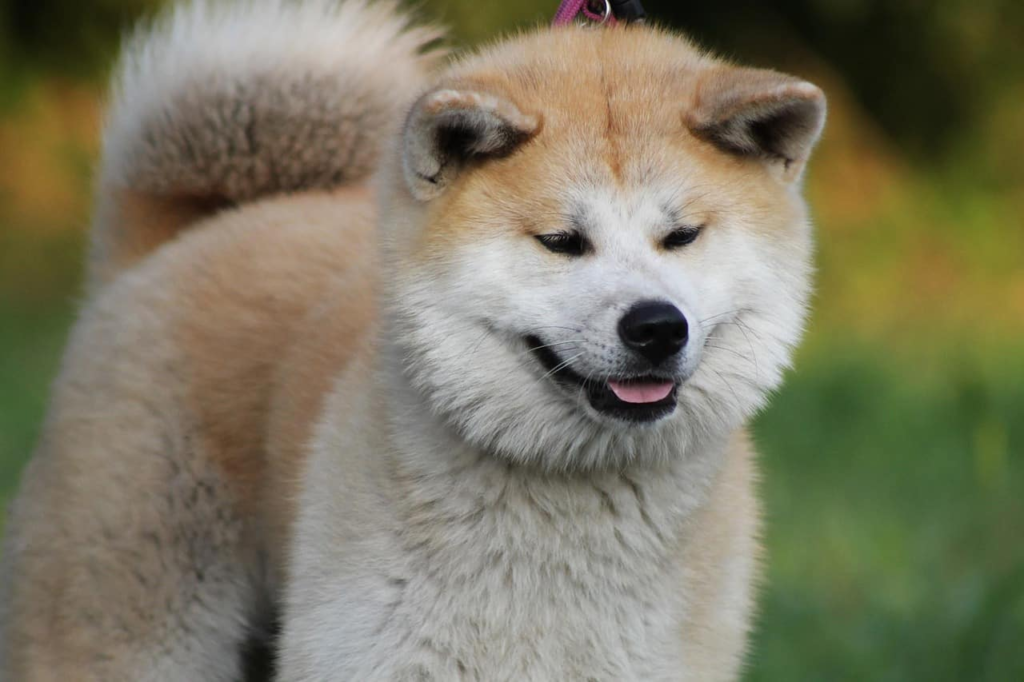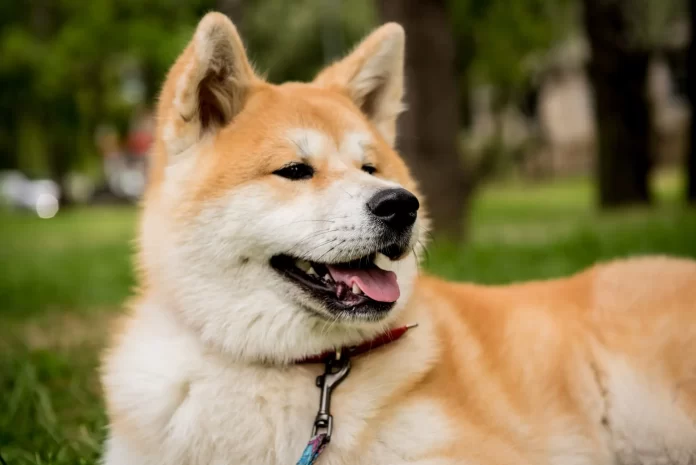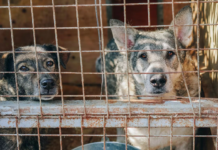Last Updated on November 23, 2023 by Fumipets
Akita Dog Breed
| Height | 31 – 36.5 inches |
| Weight | 70 – 120 pounds |
| Lifespan | 10 – 13 years |
| Colors | Black, white, chocolate, brindle, a combination of color and white |
| Suitable for | Experienced dog owners looking for a loyal and imposing guard dog |
| Temperament | Loyal, intelligent, stubborn, composed, courageous |
Meet the Akita if you’re interested in acquiring a strong, gorgeous dog that is bred to be devoted to its owner. The Akita is a big, strong dog that originated in Japan and is renowned for being highly devoted. The Japanese government classified this well-liked working dog breed as a “natural monument” in 1930. Originally bred as a hunting and fighting dog, the Akita is today utilized as a police and security dog.
In the middle of the 1930s, Helen Keller brought the first Akita to set foot on American land. While travelling to Japan, Keller received an Akita puppy as a gift. The Akita breed was included in the American Kennel Club’s (AKC) show classes in the early 1970s.
The Akita is a large-boned, furry dog with a thick coat. This breed is distinguished by its upright ears and dark, gleaming eyes, which give it a look of vigilance. The Akita is an independent thinker that lives on human company.
To find out whether this noble breed of dog is a good fit for you, keep reading to discover more about it.

3 Little-Known Facts About Akitas
1. The Akita Was Originally a Wealthy Man’s Dog
Only members of the Imperial family and members of the reigning aristocracy were permitted to own Akitas in Japan during the 17th century. Akitas had lavish lives during this period because their owners often held elaborate rituals for them. It was not unusual for an aristocratic owner of an Akita to employ caregivers to take care of their spoiled canine 24 hours a day.
2. The Akita Breed Almost Went Extinct
The government imposed stringent rationing restrictions during Japan’s active participation in World War II, which made living for the Japanese people quite challenging. Dog owners were unable to provide their dogs with the care they needed during these exceptionally difficult times. All non-military canines in Japan were to be put to death as a result of the government’s grave orders. The German Shepherd was the only breed that qualified since it is a military breed.
Devoted owners transported their Akitas to isolated regions of the nation in an effort to preserve their cherished pets. In an effort to rescue their animals, some Akita owners crossed their dogs with German Shepherds and gave them names with Germanic ancestry. Thankfully, enough Akitas survived this terrible period in history to prevent the extinction of the species.
3. There’s a Spiritual Significance Attached to the Breed
In Japan, the Akita dog breed is celebrated with a special distinction since it is so adored and well-known. Friends and relatives of the baby’s family often present them with a tiny statue of an Akita when a kid is born in Japan. This is carried out because the Akita stands for longevity, prosperity, and excellent health.
Akita Intelligence and Temperament
The Akita is brave, honorable, and utterly devoted. This breed of dog is highly regarded in its country of origin, Japan, for protecting families. The Akita is reserved, suspicious of strangers, and often intolerant of other pets. Akitas may be playful, humorous, and very devoted to their owners. This breed enjoys spending time with its owners. It is a free-thinker who is adamant about defending those it cares about.
An Akita has to be well socialized with both humans and other dogs starting at a very early age. Being the lone dog in the household makes this dog happy. It may exhibit aggressive behavior against other dogs, particularly those of the same gender.
The Akita makes a good watchdog since it may be reserved around strangers yet fiercely protective of its home. This dog is bright, yet frequent training might make him quickly bored. The breed enjoys having a task to do and thrives on difficulties.
Are These Dogs Good for Families?
If properly socialized and taught from an early age, the Akita may make a fantastic family pet. Akitas need loving guidance that is both strong and consistent. A household with small children may not be a good fit for this dog since it is a large breed that does not tolerate abuse well, whether it is deliberate or unintentional.

Does This Breed Get Along with Other Pets?
As was already noted, the Akita is infamous for having a negative attitude toward other animals, particularly canines of the same gender. The majority of other living things are seen by the Akita as either prey or a danger, despite how much it loves its human family.
The Akita thrives in homes where there is just one pet. Of course, an Akita can get along with other dogs with a lot of socialization and training from a young age. However, you must use extreme caution while housing an Akita with other dogs or animals in general.
Things to Know When Owning an Akita
Food & Diet Requirements
An Akita should be given premium dog food, whether it is made at home under the direction of your veterinarian or professionally produced, to preserve excellent health. An Akita’s food should be suitable for its age, just as with other breeds. For instance, Akita pups should be given puppy kibble, which is intended to support a puppy’s healthy growth and development. Akitas who are adults should be given adult dog food, while those who are older should be fed senior dog food.
Exercise
Despite its size, the Akita does not have a great level of energy. This breed needs little activity, such as a couple of great long daily walks or a quick jog around the neighborhood. Akitas like playing, and they enjoy chasing in particular. For this breed, a lively game of fetch is always enjoyable.
A backyard agility or obstacle course is a terrific option since this breed enjoys a challenge. Another enjoyable pastime for an Akita that calls for timing, coordination, and ability is frisbee tossing.
Training
The Akita demand strict, equitable, and constant training beginning at a young age. As soon as you bring your Akita home as a puppy, you should begin training it. As this dog might be difficult, patience is essential. Instead of rewarding your Akita with goodies, use tough orders and praise to teach them. Getting your dog to regard you as its leader is the main objective of training an Akita.
Grooming
The Akita’s medium-length double coat doesn’t mat or tangle and sheds gently. Once or twice a week brushing is recommended for this kind of dog. An Akita should be groomed from an early age so that it becomes a habit for the dog.
Akitas should have a bath around once a month after a thorough brushing. All-purpose dog shampoo will work just fine. After bathing your Akita, be sure to properly rinse the shampoo out of the coat. Next, towel-dry the coat, and give it a brief brushing to make it seem clean and pristine.
Health and Conditions
Akitas are typically in excellent health, however they might be vulnerable to some illnesses and ailments.
Minor Conditions
Heat and summer stress
Itchy skin
Cataracts
Retinal dysplasia
Serious Conditions
Hypothyroidism
Hip dysplasia
Patellar luxation
Von Willebrand’s Disease
Vestibular Syndrome
Microcytosis
Male vs Female
Here is some information that might be useful if you are determined on obtaining an Akita but are unsure of whether you should acquire a male or female. Akita males are bigger and heavier than female Akitas. Males are also more likely to have strong bonds with every member of the family. Therefore, a male can be the best option if you want a large dog that is ideal for your family.
A female Akita has less muscular mass than a man and is thinner. When young and more dependent on you for love, females are simpler to teach than males. A female Akita is also a bit less aggressive and playful than a man.
Conclusion
When you have the honor of meeting an Akita, it is impossible to overlook its stunning attractive looks. The Akita may seem like a bear cub, yet this dog is inherently highly dominating. The Akita has trouble getting along with other dogs, particularly those of the same gender. This is why getting an Akita of the same gender if you already have a dog is not a smart idea.
If you’re an experienced dog owner and prepared to give your dog strong, loving discipline, an Akita could be the ideal dog for you. The Akita is a stubborn dog that respects authority.
Respect must be shown to an Akita. This dog does not respond well to mistreatment, even when it occurs accidentally, thus it is not the ideal breed option for families with young children. When its tail is tugged or it is climbed on, an Akita can think it is being attacked and react aggressively.


















